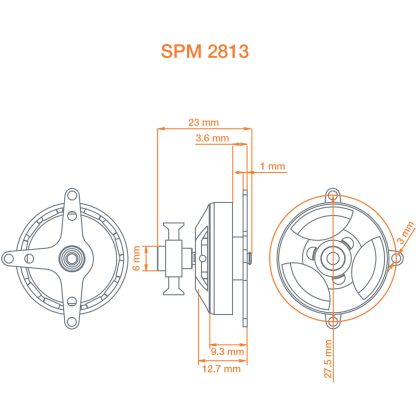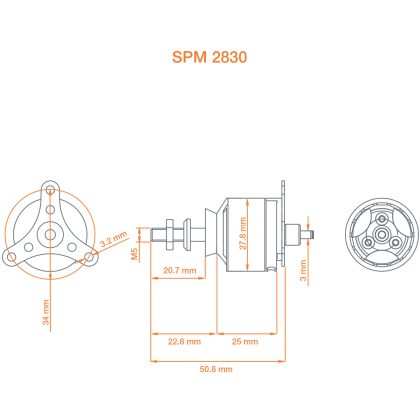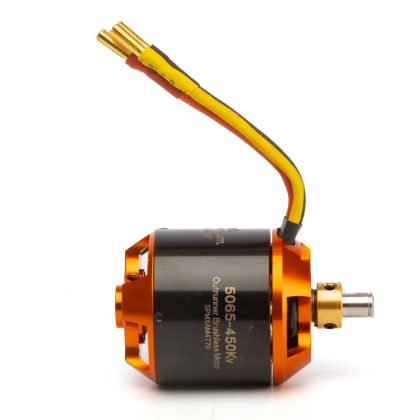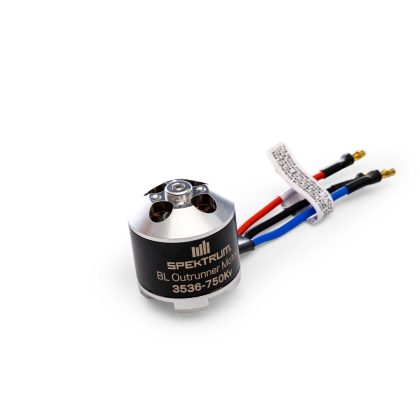 ? ? |
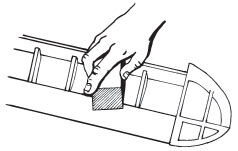 |
Surface Preparation:
The covering job can only be as good as the finish of the surface it’sapplied over. In order for the covering to properly adhere to a surface, the surfacemust first be smooth and clean. Sand the model using a sanding block andprogressively finer sandpaper, with the final sanding being done with 320 gritpaper. Vacuum away all of the dust, as specks of dust under the covering will leaveunsightly bumps. Fill gaps and dents with a high-quality filler. If usinglight-colored UltraCote? (such as white or yellow), use a tan-colored filler thatmatches the wood color to prevent the filler from showing through.
|
|
Pro Tip – Some professional builders ??raise the grain?? then sand a second time with 320 or 400 grit paper for the ultimate finish. After the model is sanded, use a damp cloth to wipe down the model. Some modelers prefer to use a fine-mist squirt bottle filled with water to dampen the surfaces to be covered. As the surface dries, imbedded wood fibers in the surface will ??stand up.?? When dry, sand the surfaces again using 320 or 400 grit paper. Raising the grain now and sanding it off will prevent the grain from raising later under the covering, creating a bumpy finish. Vacuum the model thoroughly and avoid touching the model with oily hands.Your model is now ready for covering!
|
 |
Trim Film to Size:
Start by covering the bottom of one wing half. Using scissors or sharp hobby knife, cut a piece of UltraCote? a few inches larger than needed to cover the wing. Remove the backing (save for later) and place the covering with the adhesive (dull) side down, centered over the wing. Set the covering iron to the application temperature of 220°F.
|
|
Pro Tip – If the iron you’re using doesnot display the actual temperature, here is a tip that will ensure your iron isproperly set.Water boils at 212°F. Allow your iron to warm up at a medium setting.When the iron reaches its stabilized temperature, carefully pour a few drops ofwater on the iron’s surface. Adjust the temperature until the water just begins toboil off. This method is surprisingly accurate and is generally within 10° (of theexact application temperature of 220).
|
 |
Tacking Covering to Spar:
Tack the covering to the spar or the high point of the wing, using your iron as shown (an iron sock is highly recommened). Gently pull the covering toward the root and toward the tip, as you work the iron from the center of the spar to the root and tip of the wing. Press gently with the iron, allowing the heat (not pressure) to activate the adhesive and bond the covering to the high point. Ideally, the covering will naturally lay flat against the entire surface with a minimum of wrinkles.
|
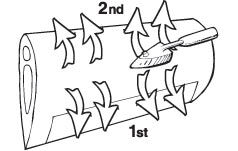 |
Covering a Solid-Sheeted Wing:
If covering a solid-sheeted wing, work from the center of the sparoutward to the trailing edge and then to the leading edge as shown, using the ironat 220°F. If a wrinkle develops, the covering can be carefully lifted and reapplied.
|
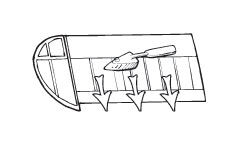 |
Covering an Open-Structure Wing:
If covering an open-structure wing, work from the spar toward thetrailing edge, gently sliding the iron (set at 220°) toward the trailing edge withthe iron contacting two ribs. Using your iron, adhere the covering to the remainingribs, working toward the tip and the root. Now complete the open structure leadingedge, using the same method. If the leading edge is sheeted, then follow thetechnique listed above under ??Covering a Solid-Sheeted Wing.??
|
 |
Sealing the Edges:
With the iron set to 220°F, seal the leading and trailing edges. Using astraight edge and a sharp #11 hobby knife, carefully trim the excess covering fromthe leading and trailing edge, allowing a minimum of a 1/4″ overlap to wrap aroundthe leading and trailing edge of the wing. Now seal the leading and trailing edgessecurely with the covering iron.
|
 |
Wing Tip:
Depending on the amount of the curvature of the wing tip, high heat (upto 350°F) may be needed to shrink and stretch the covering to eliminate all thewrinkles. Preset the iron to 300°F. Pull and stretch the covering around the wingtip while applying heat with the iron. Remember, UltraCote? can be carefully liftedand repositioned to help eliminate wrinkles. This feature is beneficial, especiallywhen covering sharply curved wing tips. Continue working, pulling, and heating thecovering around the tip until the covering is past the center of the tip. It may benecessary to increase the temperature of the iron to achieve greater shrinkage toeliminate all wrinkles. Trim the excess covering using a #11 hobby knife, thenreseal the covering on the wing tip
. |
|
Pro Tip – If sealing the covering in tight areas such as corners or fillets, usingthe Hangar 9? ProTrim Sealing Tool is very helpful and results in a professionalfinish.
|
 |
Covering the Top of the Wing:
Using the backing from the wing panel that you just covered as atemplate, cut a piece of UltraCote? to be applied to the top of the wing. Be sure tocut a top panel, making sure that the adhesive is on the correct side. Apply thecovering to the top of the wing using the same techniques as described in steps 3through 6. Be sure that the covering overlaps a minimum of a 1/4″ when trimming theedges and securely seal the edges with the iron.
|
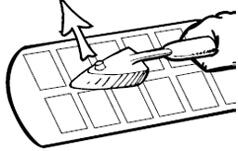 |
Shrinking the Covering:
Now it’s time to shrink the covering. With the iron set to 300°F, applyheat using the same pattern used to apply the covering starting at the spar andworking outward. It may be necessary to increase the temperature to 320°F to get ridof stubborn wrinkles. Use the minimum amount of heat necessary to tighten thecovering.
|
|
Pro Tip – Use heat, not pressure, to shrink the covering taught. If pressure isapplied, gouges can be pressed into the wood. Let heat, not pressure, do the work.
Alternate Method: A heat gun can also be used to shrink the covering. This worksparticularly well over an open structure. It can also be used over a solid structureif a Hangar 9 Covering Glove? is used to gently press the covering to the surfaceafter heat is applied.
|
 |
Covering Fuselages and Other Solid Surfaces:
The technique for covering fuselages and other simple flat surfaces isidentical to covering a solid wing. Start with the bottom, then sides, and finallythe top. First, tack the center of the surface down using an iron set to 220°F. Workoutward from the center, bonding the covering to the surface. Trim and seal theedges. About 1/4″ or more overlap is recommended when applying the next piece ofcovering. Shrink the covering, using the same method as described above.
|
| Important: Even if you’re experienced in applying other brands of covering, it’simportant to read the following instructions. UltraCote? incorporates a unique multitemperature controlled adhesive and shrinkage system that makes achievingprofessional covering results easy. |
|
Multi-Temperature ControlSystem:
Understanding the benefits of this system and how to use it will makecovering with UltraCote? easy and help to ensure professional results. When usingUltraCote?, there are three important temperatures to be aware of.
Application Tempature-220°F (100°C):
At 220°, the adhesive on UltraCote? becomes active, allowing the covering to be attached to the model.While 220° will fully bond the covering to the model, it is well below the temperature that causes UltraCote? to shrink. This is exactly what’s needed when first attaching covering to the model to prevent the covering from distorting.
|
Pro Tip –Many professional builders mark this temperature on their covering iron with a marker or striping tape for quick reference, as this temperature is used frequently whenever putting on covering.
|
Shrink On-Set Temperature-300°F (134°C)
At 300°F, UltraCote? begins to shrink. This is called the Shrink On-Set point. After the covering is attached using an iron set to 220°F, the next step is to shrink the covering. This initial shrinking is done with the iron set at 300°F.
Maximum Shrinkage Temperature-350°F (162°C)
At 350°F, UltraCote? reaches its maximum shrinking point. Raising thetemperature above this point will not cause further shrinkage.
|
| The rate of shrinkage is not directly in proportion to the temperature. The chart to the right shows how the majority of the shrinkage rate occurs between 300°F and 330°F. At higher temperatures UltraCote? continues to shrink but at a much slower rate. The smallest amount of shrinkage occurs between 340°F and 350°F. This is helpful to remember when shrinking and tightening covering. |
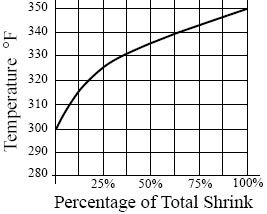 |
|
| Important: Once UltraCote? is shrunk to a specific temperature, a highertemperature must be used to further shrink the covering. For example, if thecovering was shrunk using 320°F and wrinkles begin to appear/reappear, it will benecessary to use over 320°F to achieve further shrinkage. |
|
Pro Tip – Always use the minimum heat necessary to remove wrinkles when tighteningthe covering, thus allowing plenty of shrinkage/temperature range remaining if it’snecessary to further shrink the covering.
|
|
|
|
Helpful Hints
|
|
Multiple Colors:
When applying covering with a second color, it’s important that the lightcolor be applied first (under the dark color) to prevent the dark color from showingthrough. Where colors meet or at the edge of the covering, it is important to notoverheat this area (over 300°F), as this will shrink and distort the straight edge.
Use a Sealing Iron Sock:
A covering sock placed over the iron is highly recommended, as it usuallyprevents the surface of the iron from scratching. The sock absorbs heat and willrequire the user to work slower or to turn the heat up 10%. Almost all professionalbuilders use covering socks. Hangar 9 offers one of the best that features muslin onone side to prevent heat damage and soft cotton on the other side for a soft,scratch-free finish.
Dryer is Better:
Wood naturally absorbs moisture.Wood models actually grow and shrinkslightly throughout different seasons. This can be experienced by traveling from thehumid Midwest of the United State to the dry deserts of Las Vegas. After a few daysin the desert, the model develops covering sags due to model shrinkage. It isrecommend that you cover the model in a dry climate if possible. Placing the modelin a room with a dehumidifier for several days before covering the model may preventthe covering from sagging due to model shrinkage.
Painting:
UltraCote? will accept most types of polyurethane, epoxy, and automotiveacrylic paints. It’s recommended that the surface be scuffed with 000 steel wool orScotch? bright pads then thoroughly cleaned with acetone or thinner before painting.Model Dope or butyrate-based paint are not compatible with UltraCote?.
Bubbles and Blemishes:
Occasionally the intense heat from the sun can cause bubbles andblemishes in the covering, especially when using dark colors. To remove these, heatthe bubbled area using a heat gun to expand the air under the covering, causing thebubble to rise. Quickly pop the bubble using a needle then wipe the area using acold, wet wash cloth. The wet wash cloth rapidly cools the area, allowing thecovering to re-adhere. It may take several tries to completely remove thebubble/blemish, but this method works great.
CleanUp:
The adhesive can be removed from the iron or model using acetone or amild thinner.
|
|
|
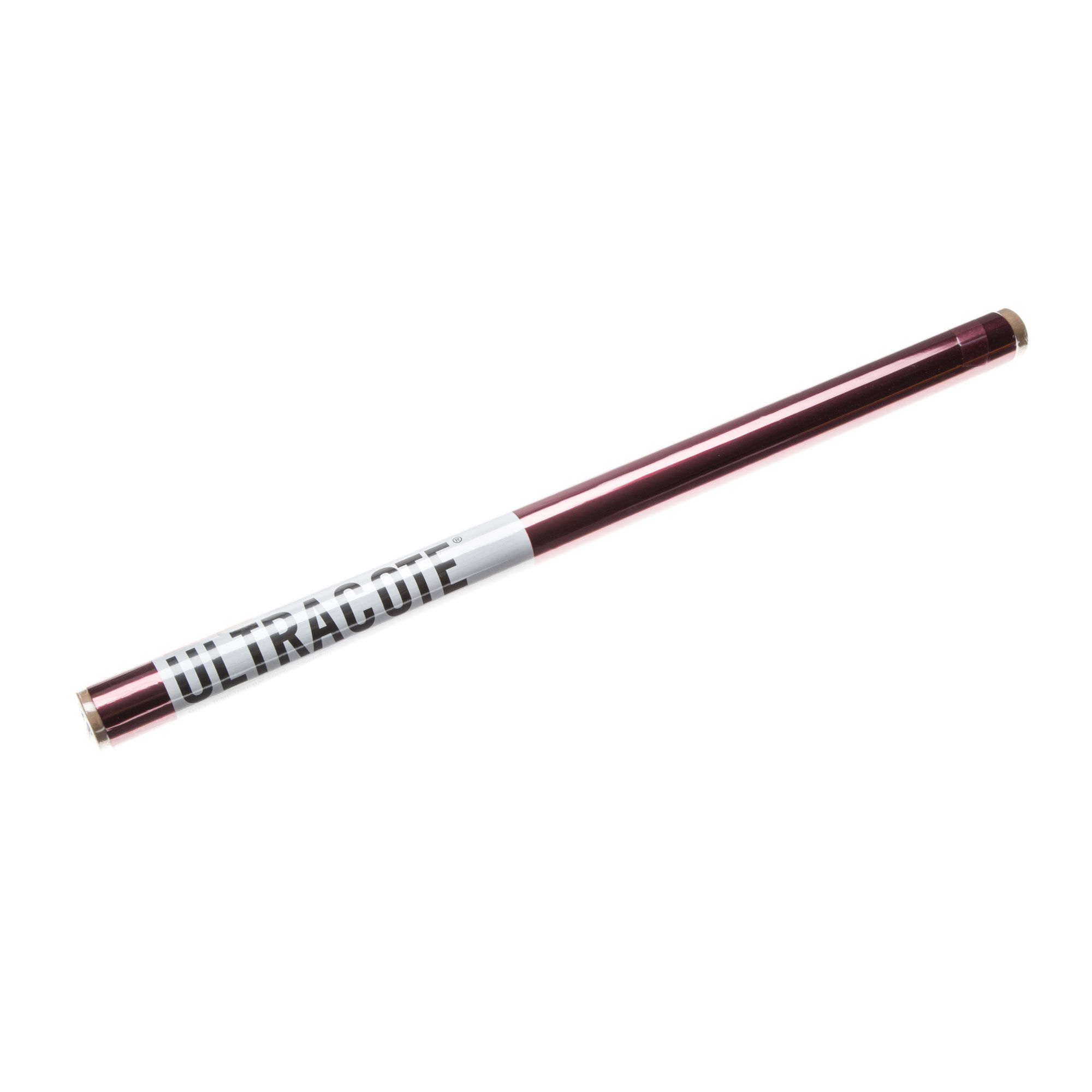
 ?
?











